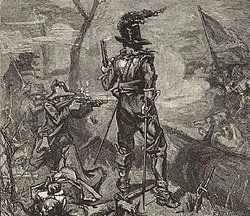Plundering Time
William Claiborne and Richard Ingle both took opportunities to seize property and pillage in an around Kent Island and St. Mary's City, Maryland.
The causes of the rebellion included William Claiborne's disputed claim with the Calverts over Kent Island, Maryland, the bitter relations between the Catholic minority elite and the Protestant majority, and the political partisanship of the English Civil War.
[citation needed] The dark period marked a combination of the fall of the British King and religious intolerance, which led directly to the event.
), the first provincial Maryland governor Leonard Calvert seized a trading post on Kent Island established by Captain William Claiborne.
[1] Although not officially allied, privateer Captain Richard Ingle seized the Kent Island opportunity to overthrow the government based at St. Mary's City.


